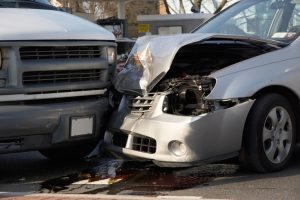
Head-on collisions consist of very few auto accidents nationwide.
Head-on Collision on Highway 46 Leaves Two Drivers Dead
According to a KSAT News report, two people are dead following a head-on collision in Seguin early Sunday morning.
Police reported the incident occurred just before 1 a.m. on November 19th, on State Highway 46 North near Cordova Road. A Jeep Cherokee was reportedly traveling South when it swerved into northbound traffic for unknown reasons. It hit a Chrysler head-on, killing both drivers. Officers say the Chrysler was engulfed in flames when they arrived. A passenger from one of the vehicles in the original crash was taken to the hospital in unknown condition. Two other vehicles later struck debris. EMS treated the drivers of those vehicles on the scene, but they did not need to go to the hospital.
Did You Know?
85% of fatalities in head-on collisions occurred on undivided highways between 2016 and 2018.
Fires and Burn Injuries in Head-on Collisions
Head-on collisions are often fatal or end in catastrophic injuries. The most obvious reason for this is the sheer force of the impact. Surprisingly, burns are one of the most common injuries reported in head-on collisions.
Let’s take a look at why burn injuries are common in head-on collision accidents and what to do if you’re burned in an auto accident.
Why Vehicles Catch Fire in Head-on Collisions
Highway vehicle fires don’t happen very often — there are only about 170,000 per year nationwide. But, they are more likely than other kinds of fire to end in fatality. Roughly 7 people die every week in a vehicle fire.
Slightly more than one-third of these fires start because of an auto accident, while a quarter started because of equipment failure. In all cases, the most common place for a fire to start in a vehicle is in the engine compartment.
- 62% — Engine/Wheel area
- 12% — Passenger Compartment
- 5% — Trunk/Cargo Area
- <2% — Fuel Line/Fuel Tank
Fires Are Not the Only Way to Be Burned in a Head-on Collision
While a vehicle is more likely to catch fire in a head-on collision, you can still be severely burned if it doesn’t. Burn injuries in head-on collisions can result from:
- Seat Belts
- Exploding Air Bags
- Scraping the Pavement
- Hot Vehicle Surfaces
- Chemical Burns from Vehicle Fluids
Types of Burn Injuries in Head-on Collisions
Burns are one of the most painful and debilitating injuries a person can experience and can have permanent effects on the victim. There are three major types of burns a person can experience in a head-on collision:
- Contact Burns — This kind of burn is the result of prolonged contact of a burning object to the skin (i.e., seatbelts, hot surfaces, fire).
- Explosion Burns — A sudden explosion can create severe scattered burns on a large area (ex., Airbag explosion).
- Chemical Burns — These burns can result from chemical contact with the skin or can be inhaled, causing internal organ damage (i.e., battery acid).
These injuries can cause permanent scarring, loss of limbs, and internal organ damage that could alter the victim’s life forever.
Burned in a Texas Auto Accident? Call Carabin Shaw
The one thing that most burn injuries from auto accidents have in common is negligence — the failure of another party to exercise their reasonable duty of care. If you were severely burned in an auto accident in Texas, you may be entitled to compensation.
Carabin Shaw has been putting clients first in San Antonio for 30 years because we care. Contact our Texas burn injury attorneys today at 800-862-1260 to find out if you qualify for compensation for free. We look forward to serving you.
Contacting a Carabin Shaw attorney is free and does not obligate you to work with the firm.
 Texas Accident & Injury News
Texas Accident & Injury News

